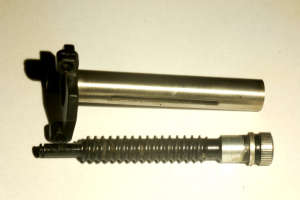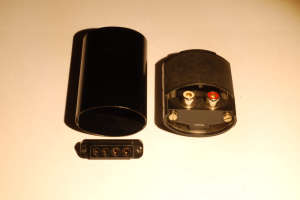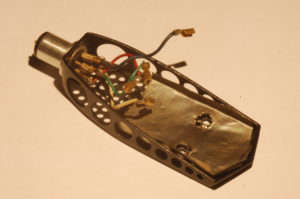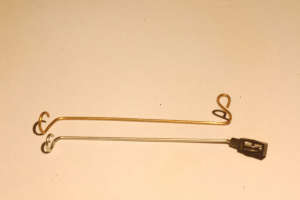For 2023, T.H.E. Show (officially, The Home Entertainment Show) was conducted at the Hilton Orange County/Costa Mesa hotel, just west of the John Wayne Airport in California. Being both close to an airport and only a block south of the 405, it provided easy access for attendees. The place was immaculately clean, well maintained, and the staff were friendly and helpful. The only mark against it was a shortage of air conditioning in the hallways.
Many airline pilots and attendants stay here. I discovered they were off to places like Australia, Africa, and South America. I thought I might be a pilot in my next life.
I also appreciated the fact that there were lots of restaurant choices within walking distance for those who preferred cuisine different from what the single hotel restaurant offered.
The hotel was attractive inside as well, with several satellite bars strategically located in case of emergencies.
Exhibitors and attendees often complain about the acoustical properties of small hotel rooms, but this place seemed to have many more conference rooms available than its T.H.E. Show predecessors. Larger rooms mean better sound. Ironically, some of the attendees complained that the exhibitors were spaced too far apart.
I enjoyed having the exhibitor rooms widely spaced as it meant that there was far less hallway congestion than we typically get at these events. Some of the attendees interpreted this as a lack of participants (or they'd have complained about the overcast skies).
The products of renowned studio engineer Alan Sides (who owned five Ocean Way recording studios across the country) has consistently been in the running for “Best sound of the Show” since he turned his attention to speaker building over a decade ago. Every iteration of his Ocean Way Audio loudspeakers, though all wildly different, has been remarkable.
This year’s model, the Sausalito MK II is no exception. What is exceptional is that such an ordinary-looking speaker produces such extraordinary sound. What’s so special about it – can it be the soft-dome tweeter, the aluminum midrange, the aluminum woofer…could it be the devil (as the Church Lady Dana Carvey might say)?
Both my audio buddy Amnon and I found the sound to be smooth, refined, detailed, yet startlingly dynamic. The bass was Mariana Trench-deep and tight. For $29,000, this seductive speaker system runs with the $100K crowd.
Equipment junkies seeking to impress their friends with a visual wow factor won’t be dazzled, but those interested in the biggest bang for the premium buck will be blown away.
Alan’s speakers were driven by $70,000 worth of AGD electronics. The 100 watt/channel (at 8 ohms) amps feature "Gallium Nitride" tubes, which aren't vacuum tubes at all, but glass containers packed with electronics. Apparently, there are some real (845) tubes in play somewhere in the system (but no analog front end).
Although the sensual Estelon speakers haven’t changed much in appearance, they seem to sound better every year, (maybe due to improved crossovers). They impressed us again this time with their tight, solid bass, crisp highs, great resolution, and impressive soundstage. These $92,000 speakers were supported with MSB electronics. Unfortunately, they weren’t supported by the lovely daughter of the designer, who was missed this year.
If you think your speakers are heavy, try moving these 430 lb. blue pearl granite speakers from Canadian manufacturer Acora Acoustics. The knuckle test revealed them to be as inert as the pre-Cambrian shield. Appropriately powered with Boulder Amplifiers equipment, this system made a rock-solid impression with deep, tight bass and outstanding dynamics. Amnon and I found the beryllium tweeter to be a bit too hot for the material they were playing, but that is a subjective opinion.
These speakers retail for $218,000/pair excluding the $8,500 stands. Make sure your shipping is prepaid.
At $16,000/pair, these Usher speakers from Taiwan are at the other end of the price spectrum – but not at the other end of the sound quality spectrum. Powered by Pass Labs monoblocks and a Pass Labs preamp ($10,000 each), they impressed us with their smooth but highly resolving sound and tight, solid bass. They feature magnesium tweeters and midrange drivers –which are claimed to be lighter than beryllium – and carbon/Kevlar woofers.
We both agreed that these speakers represented the best sonic-value at the show, sounded equal to all but the best of the more expensive systems, and would make a fine desert island speaker system for either of us.
Before the Elac and MoFi Electronics days, Andrew Jones used to host the TAD rooms, and the sound was consistently superb. This year, not so much. The Jones’ designed speakers featuring concentric drivers were still on display, but the acoustics didn’t benefit from the magical Andrew touch, so the sound was much less impressive. We know from experience, however, that these are excellent components capable of producing serious audiophile sound.
A friendly Bob Sattin, from Bob’s Devices, demonstrated step-up transformers for moving coil cartridges on various headphones. I’ve heard many good things about him from San Diego Music and Audio Guild members, but what do they know?
Just down from Bob’s booth, Upscale Audio was demonstrating single ended triode vacuum-tube headphone amps.
An audio show can’t be all work, so T.H.E. Show organizers provided a hospitality room…
…with a complimentary pasta buffet.
They also offered a complimentary scotch tasting hosted by a pleasant fellow from Lismore scotch (right). I discovered that if you waited till were a lot of tasters, he got confused and you might get two rounds (or maybe he just appreciated your appreciation). I preferred the 18-year-old stuff to the 7 or 14-year-old.
Here the show organizers are enjoying their drinks on the patio adjacent to the hospitality room. That’s Maurice Jung and the charming Emiko Carlin on the extreme right.

As usual, there was a large room with lots of vinyl at T.H.E. Show. This shot was taken first thing Friday morning, before the event even officially opened.

The affable and ageless Andrew Jones gave a lecture on speaker design and system priorities to a packed room on Saturday afternoon. It was nice to be able to ask him some questions.
It was great to see a pair of Klipschorns from Klipsch at this event, powered by gorgeous Pathos electronics. The system was augmented by a subwoofer and the sound was impressive. Klipschorns have come a long way since the 1940s.
TriangleART had one of the most beautiful rooms at the show, which is not apparent in this photo because the lighting featured the sign instead of the equipment. This is not my idea of sound marketing, but it’s not my company.
Siegfried Linkwitz lives still through his creation, the LX521 dipole speakers. I heard the previous iteration of these speakers in Siegfried’s home some 15 years ago, and was struck with how “live” and natural the piano sounded in a relatively small space. They were less impressive in this huge room. The speakers now sell with a crossover for $19,500 for the system, or with digital amplifiers for $23,000.
For $4,500, Tony from Tonian Labs knocked the biggest-bang-for-the-buck award out of the park with these bookshelf speakers in the Oriaco room. There were lots of bookshelf speakers at T.H.E. Show, but none of them were as inexpensive or jaw-dropping as this pair. Attendees refused to believe there weren’t subs in the room and some even looked around for a hidden one. The dynamics were startling from the 6-inch paper driver and ring radiator tweeter (powered by a Denon integrated amp!). The top-firing, soft-dome tweeter added a soundstage you’d usually hear from a much larger speaker.
Want big sound in small room? Don’t want to spend $10K on electronics? Love rock music? This box is for you.
I still have a pair of Radio Shack speakers (circa 1980s – 1990s) in the garage featuring the clever Linaeum dipole ribbon tweeter. Unfortunately, Radio Shack married this brilliant tweeter with a mediocre woofer/midrange driver, resulting in a mediocre system. I often wished for more.
MC Audiotech has done just that. The original engineer of the Linaeum tweeter, Paul Paddock, has designed a 6-inch “bending wave” or “airfoil” version of the Linaeum tweeter, stacked three of them to make an 18-incher, and crossed the stack over at 300 Hz to a 12-inch woofer. This results in a seamless sound with outstanding midrange, smooth highs, and solid bass. The vents in the side accommodate the broad dispersion of the tweeter, though I would have thought open sides like the Vandersteen Model 2s would be more effective.
This $100,000 speaker, powered here by David Berning electronics, produced very satisfying, room filling sound that should appeal to many well-heeled audiophiles.
The High End by Oz room was bigger than life, just like Oz himself (both in size and personality). Once you meet him, you won’t forget him. I was in his sound room twice, but on both occasions, the tame music he was playing would have sounded as good on a pair of decent stand-mount monitors.
“If you’re going to have a big system, why don’t you play big music, Oz?” I asked. He invited me back at 8:00 in the evening for an afterparty, which we showed up for, twice. On both occasions, the room was locked and there was no sound emanating from inside.
I gave him a hard time about it the next day and he swore he was in there (must have been sleeping). I figure he should bring a fine bottle of scotch for the next afterparty.
On Saturday, we came back and insisted on some BIG music; “Take Five” by the Dave Brubeck Quartet. The $100K Lansche Audio speakers with plasma tweeters powered by Thrax electronics came to life. The room-filling sound was exciting and stimulating. People poured in from the hallway to listen. The tweeters and midrange were clean, highly resolving and free of anomalies. The woofers filled the room with bass, although they were not as tight as I expected. This may have been due to room anomalies. Some of the rooms were separated by flimsy, moveable walls.
When I come back from an audio show, everyone always wants to know, “which system was the best?” The answer is seldom the same from different reviewers.
However, of all the systems at the hotel, both Amnon and I agreed that this system in this room best demonstrated the effortless dynamics, bandwidth, and neutral tonal character of a live performance. It sounded equally good on orchestra, classical piano, jazz, and vocals. The dynamics and soundstage were remarkable, even at low volumes.
We’ve heard many PBN Audio systems at audio shows over the last 21 years. They were good, but never the best. They lacked the top-end extension and the airy soundstage of the finest systems. When PBN owner Peter Noerbaek (above), switched to the ribbon tweeters in this $100,000 top-of-the-line M! Series, it was transformed, and so was our assessment of PBN.
PBN designed and constructed all the accompanying electronics as well. What other manufacturer is capable of doing that?
For a consumer loudspeaker system, a passive crossover is necessary. Few speaker manufacturers build one as sophisticated as this. It takes an expert to get it right.

An artist had placed beautiful artwork all over the show, but I couldn’t find his/her name anywhere.
Overall, we really enjoyed this year’s T.H.E. Show. It was large enough to fill two days, spacious enough to avoid serious congestion, and with lectures, exotic cars, live music, and a hospitality room, the show was varied enough to give us a break when our ears wore out.
I look forward to attending another one at this venue next year.
T.H.E. Show will return to the Hilton Orange County/Costa Mesa hotel in 2024 – Ed.]
























































































































